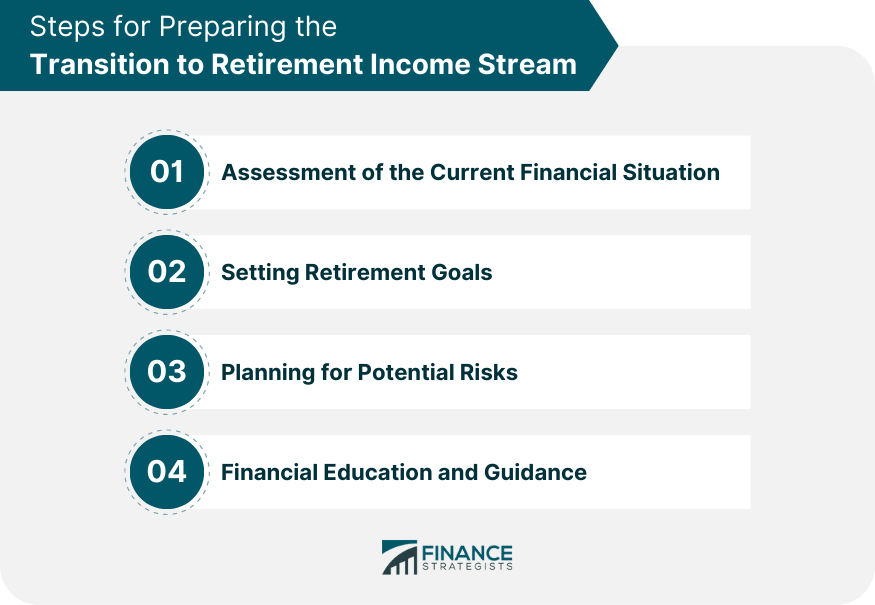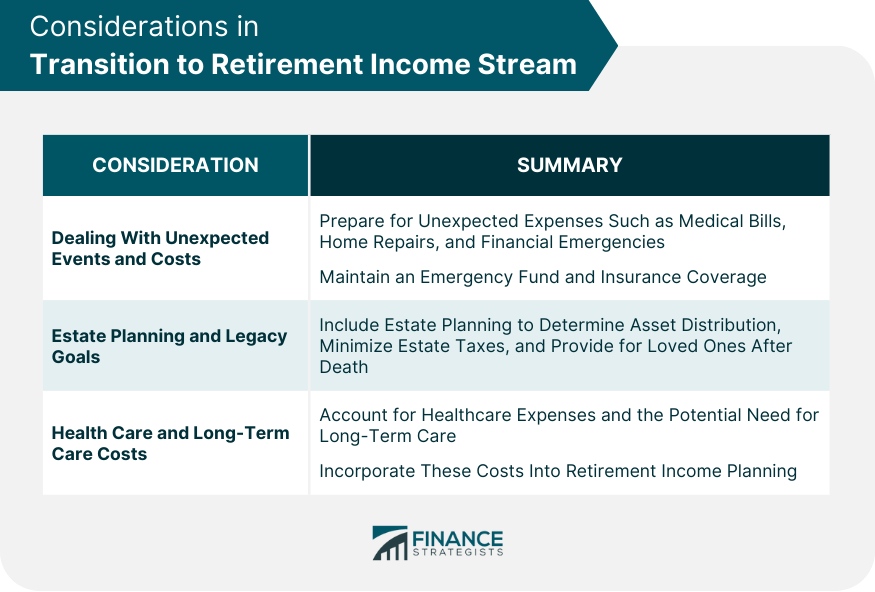The Transition to Retirement (TTR) income stream is a financial strategy aimed at providing individuals with a consistent source of income as they approach retirement. It allows individuals who have reached preservation age but are not yet fully retired to access a portion of their superannuation as a regular pension payment while continuing to work full-time, part-time, or on a casual basis. The purpose of the TTR income stream is to boost retirement savings or ease into retirement by reducing working hours without reducing income. This strategy is crucial in achieving a smooth and comfortable transition into retirement by mitigating the potential financial shock often associated with the cessation of regular employment income. It also enables a degree of flexibility and control over one's retirement planning, effectively bridging the gap between active employment and full retirement. Preparing for the transition to a retirement income stream requires thoughtful planning and proactive measures to ensure your financial well-being in retirement. Here are the steps involved: Start by taking a comprehensive look at your current financial status. This includes your savings, investments, liabilities, and expected retirement benefits. Having a clear understanding of where you stand financially will serve as the foundation for your retirement planning. Once you have a grasp of your current financial situation, the next step is to set clear and realistic retirement goals. Consider your desired lifestyle in retirement, the income you'll need to support this lifestyle, and your expected retirement age. Retirement planning involves preparing for uncertainties, including changes in the economy, potential health issues, and unexpected life events. It's crucial to factor these potential risks into your plan and develop strategies to manage them effectively. Equip yourself with the necessary financial knowledge to make informed decisions about your retirement income. This could involve self-study or seeking professional advice to help you navigate the complexities of retirement planning. Setting up diverse income streams for retirement is a critical step in ensuring financial stability. It begins with identifying and investing in various income-generating assets. First, ensure you maximize your social security benefits and any employer-sponsored retirement plans, as these often provide a steady income stream. Second, consider personal savings and investments, such as IRAs, 401(k)s, stocks, bonds, and mutual funds. These can offer potential growth and inflation protection. Finally, consider income from real estate, such as rental properties or part-time work during retirement. The key is to diversify your sources to mitigate risks and ensure a steady cash flow. The way you structure your retirement income stream can significantly impact its longevity and efficiency. This involves careful timing and sequencing of income sources. For instance, you may decide to delay tapping into your pension or social security benefits to allow for maximum growth while drawing from your personal savings in the early years of retirement. Sustainable withdrawal rates are also critical to ensure your savings last throughout retirement. This requires a balance between meeting your current spending needs and preserving your savings for future years. Finally, tax efficiency is an essential aspect of structuring your retirement income. By strategically drawing from different accounts, you can potentially minimize your tax liabilities and extend your savings. Retirement planning doesn't end once you retire. Regularly reviewing and adjusting your retirement plan is crucial to ensure it remains aligned with changing market conditions and personal circumstances. For instance, significant market downturns may require you to adjust your withdrawal rates or delay certain expenditures. On the other hand, changes in personal circumstances, such as health issues or changes in marital status, may necessitate adjustments in your retirement income strategy. In addition to financial strategies, lifestyle choices can significantly impact the sustainability of your retirement income. This includes living within your means, reducing unnecessary expenses, and maintaining a healthy lifestyle to minimize medical costs. While retirement is a time to enjoy the fruits of your labor, it's also important to make prudent decisions to preserve your financial stability. While a well-crafted retirement plan can provide a roadmap for a secure retirement, it's also important to prepare for the unexpected. This could be sudden medical expenses, a major home repair, or a financial emergency in the family. Having an emergency fund and appropriate insurance coverage can help mitigate these unexpected costs. Retirement income planning should also consider estate planning and legacy goals. This involves deciding how your assets will be distributed upon your death, potentially minimizing estate taxes, and ensuring your loved ones are taken care of. Healthcare costs are a significant concern for many retirees. In addition to regular healthcare expenses, the possibility of needing long-term care is a reality that many older adults face. Planning for these costs is an essential part of retirement income planning. The transition to a retirement income stream is a significant process requiring extensive planning and strategic implementation. Key to this process is thorough financial assessments, clear goal setting, and preparing for potential risks. Diversification plays a pivotal role in securing financial stability, and effective structuring of your income stream can significantly enhance its longevity and efficiency. Regular review and adjustments of your retirement plan are critical, along with the adoption of a sustainable lifestyle. Special considerations such as dealing with unexpected costs, estate planning, and healthcare costs must also be incorporated into your strategy. Embracing these fundamental principles can ensure a smooth transition, providing financial security and comfort in your retirement years and allowing you to enjoy the fruits of your labor while preserving your financial well-being.Transition to Retirement (TTR) Income Stream Overview
Preparing for the Transition to Retirement Income Stream
Assessment of the Current Financial Situation
Setting Retirement Goals
Planning for Potential Risks
Financial Education and Guidance

Implementing the Transition to Retirement Income Stream
Setting up Diverse Income Streams for Retirement
Structuring the Retirement Income Stream
Managing the Transition to Retirement Income Stream
Regular Review and Adjustment of the Retirement Plan
Embracing a Sustainable Lifestyle in Retirement
Special Considerations in Transition to Retirement Income Stream
Dealing With Unexpected Events and Costs
Estate Planning and Legacy Goals
Health Care and Long-Term Care Costs

Conclusion
Transition to Retirement Income Stream FAQs
A Transition to Retirement (TTR) income stream is a financial strategy that allows individuals who have reached preservation age but are not yet fully retired to access a portion of their superannuation as a regular pension payment while continuing to work.
To prepare for the transition to a retirement income stream, you should assess your current financial situation, set clear retirement goals, plan for potential risks, educate yourself about retirement income options, and implement diverse income streams for retirement.
Structuring your retirement income stream involves careful timing and sequencing of income sources. You may delay tapping into your pension or social security benefits to allow for maximum growth, draw from personal savings in the early years of retirement, and ensure sustainable withdrawal rates to make your savings last throughout retirement.
When managing the transition to a retirement income stream, it's important to regularly review and adjust your retirement plan, embrace a sustainable lifestyle, prepare for unexpected events and costs through emergency funds and insurance coverage, consider estate planning and legacy goals, and plan for healthcare and long-term care costs.
Diversification is crucial for retirement income stability because it helps mitigate risks. By setting up diverse income streams, such as maximizing social security benefits, utilizing employer-sponsored retirement plans, investing in various assets like IRAs and stocks, and considering income from real estate or part-time work, you can ensure a steady cash flow and minimize the impact of market fluctuations.
True Tamplin is a published author, public speaker, CEO of UpDigital, and founder of Finance Strategists.
True is a Certified Educator in Personal Finance (CEPF®), author of The Handy Financial Ratios Guide, a member of the Society for Advancing Business Editing and Writing, contributes to his financial education site, Finance Strategists, and has spoken to various financial communities such as the CFA Institute, as well as university students like his Alma mater, Biola University, where he received a bachelor of science in business and data analytics.
To learn more about True, visit his personal website or view his author profiles on Amazon, Nasdaq and Forbes.













